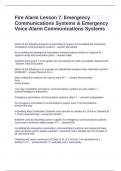-
1. Exam (elaborations) - Fire alarm test questions and answers fully solved
-
2. Exam (elaborations) - Fire alarm questions and answers fully solved
-
3. Exam (elaborations) - Fire alarm system lvl 1 questions and answers graded a+
-
4. Exam (elaborations) - Fire alarm systems 33408 questions and answers 100% solved
-
5. Exam (elaborations) - Fire alarm exam questions and answers graded a+
-
6. Exam (elaborations) - Fire alarm systems nccer study guide question's and answers
-
7. Exam (elaborations) - Fire alarm midterm questions and answers fully solved
-
8. Exam (elaborations) - Fire alarm guide questions with solutions 2024
-
9. Exam (elaborations) - Fire alarm systems level ii lesson 1. advanced detection topics questions and answers...
-
10. Exam (elaborations) - Fire alarm lesson 5&6 questions and answers 100% correct
-
11. Exam (elaborations) - Tfm 12 fire alarm technical questions and answers fully solved
-
12. Exam (elaborations) - Fire alarm lesson 6. system interfaces & safety control functions questions and answe...
-
13. Exam (elaborations) - Oh, fire alarm study materials questions and answers 100% accurate
-
14. Exam (elaborations) - Fire alarm system components and functions questions and answers
-
15. Exam (elaborations) - Fire alarm lesson 8. plans & specifications questions and answers 100% accurate
-
16. Exam (elaborations) - Fire alarm systems work sheet questions and answers fully solved
-
17. Exam (elaborations) - Fire alarm systems chapter 2 questions and answers graded a+
-
18. Exam (elaborations) - Fire alarm systems i - chapter 4 quiz review. notification appliances questions and a...
-
19. Exam (elaborations) - Fire alarm lesson 2. fundamentals & system requirements questions and answers 100% ac...
-
20. Exam (elaborations) - Fire alarm concept checks & review questions 100% solved
-
21. Exam (elaborations) - Fire alarm highlight, fire alarm concept check, fire alarm review questions and answe...
-
22. Exam (elaborations) - Basic fire alarm questions and answers graded a+
-
23. Exam (elaborations) - Fire alarm level 1 quizzes questions and answers 100% solved
-
24. Exam (elaborations) - Fire alarm systems questions and answers 2024
-
25. Exam (elaborations) - Fire alarm final questions and answers 100% solved
-
26. Exam (elaborations) - Chapter 14 test fire detection and alarm systems questions and answers graded a+
-
27. Exam (elaborations) - Fire alarms systems questions and answers fully solved
-
28. Exam (elaborations) - S-95 supervision of fire alarm systems questions and answers graded a+
-
29. Exam (elaborations) - Types of fire alarms and detection systems questions and answers latest updated
-
30. Exam (elaborations) - Fire alarm code questions and answers 100% accurate
-
31. Exam (elaborations) - Fire alarm systems i - chapter 3 quiz review. initiating devices questions and answer...
-
32. Exam (elaborations) - Nccer 26405 fire alarm system questions and answers rated a+
-
33. Exam (elaborations) - Fire alarms - module 26405 questions and answers 100% solved
-
34. Exam (elaborations) - Fire protection systems, chapter 26 (complete) questions with solutions
-
35. Exam (elaborations) - Fire alarm installation methods- state exam questions and answers latest updated
-
36. Exam (elaborations) - Fire alarm 2 questions and answers graded a+
-
37. Exam (elaborations) - Fire alarm lesson 7. emergency communications systems & emergency voice-alarm communi...
-
38. Exam (elaborations) - Fire alarm lesson 5. wiring & wiring methods questions and answers 2024
-
39. Exam (elaborations) - Level 4 module 5 fire alarm systems questions and answers
-
40. Exam (elaborations) - Chapter 9 fire alarm systems questions and answers 100% solved
-
41. Exam (elaborations) - Fire alarm systems i chapter 1 quiz 1 review questions and answers 100% verified
-
42. Exam (elaborations) - Nicet level 1 fire alarm inspection & testing questions and answers graded a+
-
43. Exam (elaborations) - Nicet i - fire alarm questions and answers graded a+
-
44. Exam (elaborations) - Ohio fire alarm questions and answers 2024
-
45. Exam (elaborations) - Fire protection systems chp 4. types of fire alarm systems quiz 100% solved
-
46. Exam (elaborations) - Electricity level 4 section 5 questions with correct answers
-
47. Exam (elaborations) - Chapter 26 fire detection, suppression, and smoke control systems quiz questions and ...
-
48. Exam (elaborations) - Alarm systems and smoke alarms questions and answers 2024
-
49. Exam (elaborations) - Chapter 7. fire protection systems questions and answers 100% solved
-
50. Exam (elaborations) - Ch. 37 fire detection questions with solutions
-
51. Exam (elaborations) - Chapter 20 fire protection systems questions and answers
-
52. Exam (elaborations) - Fire alarm exam questions and answers 2024
-
53. Exam (elaborations) - Fire detection, protection, and suppression questions and answers graded a+
-
Show more




